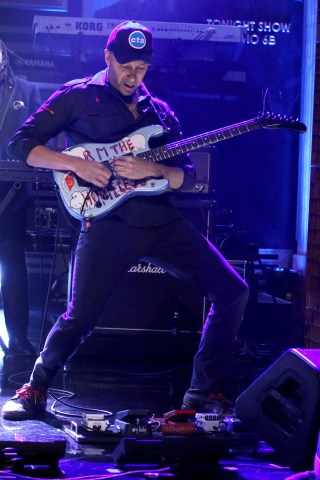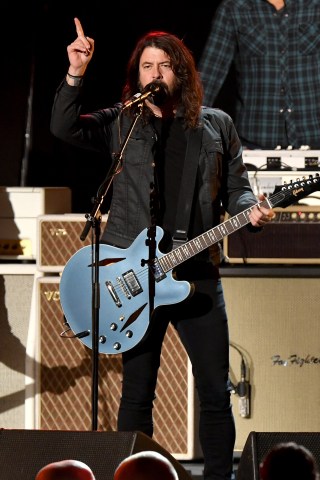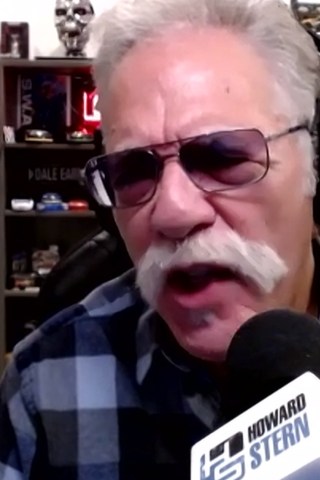Tom Morello on Mastering Metal at Harvard, Stripping for Hot Tub Money, and How Rage Against the Machine’s Breakup Let Him Rock Alongside Bruce Springsteen and Chris Cornell
Legendary guitarist, songwriter, and radical joins the Stern Show to discuss his new suite of SiriusXM gigs
February 24, 2021
On the 1996 track “Vietnow,” Rage Against the Machine famously sings “Turn on the radio. Nah, fuck it—turn it off.” Twenty-five years later, guitar virtuoso, radical activist, and the song’s co-writer Tom Morello is asking fans to turn it back on so they can hear him on SiriusXM.
The legendary rocker joined the Stern Show on Wednesday morning and let listeners in on everything from his very nearly unique backstory (thanks, Obama) and multi-faceted career as a founding member of acts like Rage Against the Machine, Audioslave, Prophets of Rage, and the Nightwatchmen to side jobs ranging from exotic dancer in Hollywood to touring guitarist for Bruce Springsteen’s E Street Band. While Rage Against the Machine is certainly one of the defining bands of Tom’s career, if not an entire generation, it’s not the only career achievement he’s proud of. He’s released a whopping 20 albums in total and, in some ways, it was the band’s breakup that created the space he needed to branch out.
“I’ve been in a band with [Rage Against the Machine’s] Zack de la Rocha, one of the greatest frontmen of all time. I’ve been in a band with [Audioslave’s] Chris Cornell—one of the greatest singers of all time. I’ve been in a band with Bruce Springsteen, one of the greatest artists of all time—and, in addition to that, I’ve been able to have a very meaningful solo career that’s been completely fulfilling. Now, those opportunities were allowed to happen because bands come and go” he told Howard. “That’s just the way the dice have rolled and I wouldn’t change that for anything.”
But Howard wondered how a band with so much chemistry could break up in the first place.
“I treasure that chemistry and those relationships,” Tom said of his Rage Against the Machine bandmates, singer de la Rocha, Tim Commerford, and Brad Wilk. “But rock bands are rock bands and they’re made of creative people who sometimes have differences and sometimes those differences outweigh the moment.”
Thankfully for Rage fans, those differences may have subsided over time. The band has once again reunited with plans to tour again as soon as the pandemic subsides.
“The world needs bands—not just Rage— but needs bands that speak with a voice of authenticity, bands that speak in an unapologetic way,” Tom said.
While the quarantine forced Rage Against the Machine to press pause on its tour, it has also allowed Tom to press play on several different SiriusXM projects. He already hosts One Man Revolution, a show on Lithium filled with personal anecdotes, random musings, and a curated playlist of songs exemplifying Tom’s eclectic musical tastes and unique sound. On Wednesday morning, he announced plans to launch three new music channels–Battle Hymns Radio, Heavy Metal Happy Hour Radio, and Riffs, Rhymes, & Rebellion Radio–and his own star-studded podcast.
Libertyville, U.S.A.
Tom records One Man Revolution at home and often incorporates conversations with his 97-year-old mother and roommate, activist and retired high school teacher Mary Morello.
“Mary Morello is a force of nature,” Tom said.
Mary met and married Tom’s father Ngethe Njorogea, a Kenyan activist turned diplomat, while living in Africa in the early 1960s. The two divorced when Tom was still a baby and she moved her son to Libertyville, Ill., a small town 40 miles outside of Chicago which didn’t exactly welcome a single white mother and her young Black son with open arms.
“There were challenges,” he said, explaining his family was the very first to integrate the town.
Tom’s mother struggled with finding work as a public high school teacher despite being vastly overqualified. “They said you could teach here but you can’t live in our community,” Tom explained. “The real estate agent had to go door to door in the apartment building and ask the other residents if they were cool with, you know, this one year old black kid moving in. How they sold me, the pitch, was ‘This is no ordinary American negro moving in. This is an exotic person of east African descent.’”
“Let me tell you, that works, Howard, until they’re old enough for you to date their daughters,” Tom continued. “You can be the king of Nigeria, man—it’s homecoming night and on that welcome mat there’s a dude out there with his arms crossed.”
The racism didn’t stop there. When Tom was 15, a few men accosted him in a restaurant parking lot with a noose and racial epithets. Many years later, he recalled a completely different experience when walking through the same parking lot during a parade held in his honor: “Now, there’s friendly residents saying, ‘We love you, Tommy,’ ‘Bulls on Parade, Tommy.’”
While he didn’t connect with his father until much later in life, Tom thinks that relationship—or lack thereof—did contribute to his passion for music. “They say no great art is made without a chip on your shoulder and I think that, looking back, may be one of those chips,” he told Howard.
Libertyville, meanwhile, became more ethnically diverse over the years but the racism never went away completely. “At the absolute height of Audioslave’s arena rocking popularity, I got put in handcuffs by Libertyville cops for walking down the sidewalk in Libertyville. Just walking down the sidewalk, coming back from a friends bar,” Tom told Howard, “You just have to survive that moment. You just have to live through it.”
Despite how the community sometimes treated Tom and his family, he isn’t bitter. “I have a complicated relationship with that town, but it’s a big part of who I am,” he told Howard.
The Electric SHeep and An Inauspicious Start
An exceptional student, Tom eventually became the first person from his town to attend Harvard University. While school came naturally to him, the same could not be said for rock and roll. He was 17 when he first seriously picked up a guitar, but that didn’t stop him from forming a band with kids from the high school drama club. “I don’t know how to play a note on the guitar and I announce a punk band is forming. I’m the guitar player. If you want to be in it, raise your hand—no experience required,” he recalled, explaining one of his recruits was eventual Tool guitarist Adam Jones.
Tom signed them up for the school talent show where his band was asked to play alongside two acts with far more experience. “There’s a band called Destiny and they are like the most beautiful men in the school with the most beautiful hair and they cover REO Speedwagon and Styx and the girls go mad. And then there’s Epitaph … they play Sabbath covers and they smoke weed and we fear them but we respect them. And then there’s my band … the Electric Sheep, that’s me and Adam Jones,” he continued. “Me and Adam can’t tune our fucking guitars.”
Electric Sheep was tasked with covering Steppenwolf’s “Born to Be Wild” and they struggled to play it well, but what Tom lacked in skill he made up for in swagger.
“We come out and the keyboard player comes in with the wrong chord … and I’m of course out of tune … It’s an inauspicious start to my career,” he recalled. “When the chorus of the song comes in, I leap off the riser and the roof comes off the fucking auditorium. People go crazy. We don’t sound good but all of a sudden rock and roll is happening.
“We destroyed Destiny’s ass that night and I realized at the end of that show that this is what I want to do,” he added. “The Holy Spirit of rock and roll was in me.”
Mastering Metal at Harvard
Despite being a natural born showman, Tom still needed to learn his instrument. What better place to do that than one of America’s most prestigious universities? He was determined to be self-taught, though he did receive one trajectory-shaping lesson from prominent Chicago-area metal guitarist Michael Angelo Batio.
“[He] gave me like sort of one page … [and said] if you want to become technically adept at the instrument, practice this stuff really slow and when you master it play it a little bit faster … that gave like at least some template,” Tom recalled, explaining he took the advice with him to Harvard where he then faithfully dedicated at least four hours each night toward mastering his instrument.
Tom did his best to paint Howard a picture of how much he stood out amongst his classmates in Cambridge. “I’m a full-on metal dude,” he said. “One of my roommates was pre-med … one of them was a big fan of opera, and here I am like jamming along with Mötley Crüe and Grim Reaper records in my leopard-striped spandex pants with a bandana tied around my thigh.”
The more Tom practiced the better he became, which only served to further fuel his obsession. “Looking back, there was a different sort of psychological itch that it was scratching and I think it had to do with control,” he said. “When it came to the guitar, the only determining factor of how that was going to go was my will. And I had will … I had a lot of will.”
“It really was a calling, like I did not have a choice in the matter,” he added.
Howard noticed several similarities between Tom’s story and that of former President Barack Obama, who also grew up in Illinois, had a Kenyan father, and graduated from Harvard.
Tom agreed the parallels were uncanny. “When [Obama] first came on the scene and basically told his life story, my jaw was on the floor. I thought I had a singular, unique president and it was like, ‘Wait a minute, the guy who is going to be president is also the Harvard-Kenya-white mom-Illinois guy? Really?’”
Getting Naked for Good (and Bad) Causes
Tom was a talented musician when he moved to Los Angeles, but talent alone doesn’t pay the bills. He struggled to find a job early on and even music stores wouldn’t hire him because of his lack of experience. He told Howard that at one point he and his roommate worked as bachelorette party strippers. It was a side gig they hoped would pay for a rather unusual upgrade for their one-bedroom Hollywood apartment.
“To enhance our dating lives we thought the thing that would help was to have a hot tub in our living room, so … we figured out how much it would take to buy this indoor kiddie pool, a water heater, and this, that, and the other to sort of simulate an indoor water activity—and then we worked toward that with this extracurricular activity in mind,” he told Howard.
Co-host Robin Quivers could barely believe it. “You could have Tom Morello come to your bachelorette party?” she asked.
In actuality, Tom said being an exotic dancer wasn’t all that great. “You’re wearing a suit, you knock at the door, ask for a cup of sugar, ‘Brick House’ comes on the stereo—it wasn’t awesome,” he recalled “We were just making a certain amount of money to get that horrible hot tub in our place. Then we did. Then we retired.”
But that wasn’t the last time Tom got naked on the job. At Lollapalooza ’93 in Philadelphia, Rage Against the Machine famously appeared nude on stage to protest the Parents Music Resource Center (PMRC), an organization which sought to censor music. Howard appreciated the political statement, but he wondered if Tom and his bandmates worried about letting it all hang out on stage.
“Sometimes you know, you gotta suffer for your art, Howard. That’s the way I look at it,” Tom said with a laugh.
The guys stood naked on stage for 15 minutes that day to make their point and then left without playing a single song, which Tom said ticked off the music industry suits in the audience. “ I remember talking to one of the record executives after that and he was like, ‘Thanks a lot for that.’ I was like, ‘Hey, man, if you sign a band named Rage Against the Machine you get rage against the machine,’” he recalled.
Audioslave Assemble
Tom told Howard he didn’t enter into any major depression after Rage broke up in 2000. Instead, he and his former bandmates Wilk and Commerford went over to mega-producer Rick Rubin’s house with the intention of making new music. Little did they know they’d soon be forming a supergroup with Chris Cornell.
“We listened to ‘Badmotorfinger’ by Soundgarden a lot and we said, ‘Maybe we should talk to that dude,’” Morello recalled.
So, they all piled in Tom’s old Chevy Astro van and drove up to Cornell’s uninviting old mansion. “The doors open straight up Addams Family-style, like with nobody opening the doors. And here comes Chris, lanky, 6-foot-2 … and he comes kind of, slowly loping, you know, down the steps and Rick turns to me and goes, ‘Let’s get the fuck out of here.’ Like our souls are in peril … it was weird,” Tom recalled.
They stayed, of course, and Audioslave was born. Though the band was more apolitical than Tom had initially imagined, it was immensely successful. They released three successful albums, a string of hits, and sold out arenas all over the world.
Cornell walked away from the band in 2007, ten years before he’d take his own life.
“Chris was smart, and you could tell. And he was poetic … he also unapologetically embraced the big riff rock,” Tom said of his former lead singer. “While Chris was a friend and Chris was a bandmate, I never stopped being a fan of his … he would effortlessly create something that was either beautiful or terrifying.”
BRUCE SPRINGSTEEN IS A JEDI MASTER
With a large picture of him performing with Bruce Springsteen looming in the background, Tom spoke of his relationship with the rock icon and former boss. “I’m not a casual Bruce Springsteen fan,” he admitted of Springsteen, whom he first became acquainted with when Rage Against the Machine covered his 1995 folk ballad, “The Ghost of Tom Joad.” “I was a superfan, like I would see him, you know, at like the Sony party and have to restrain myself from kissing his head. He is the only friend that I have to which I subscribe to a fanzine about.”
While that was back in the 1990s, the two didn’t perform together until Bruce and the E Street Band’s 2008 Magic Tour, an experience Tom will never forget. “I’ve played many shows in many arenas and stadiums and things like that, I’ve never been more nervous than prior to this rehearsal,” he confessed before recalling that while he prepared to play “Tom Joad” one way, Bruce had other ideas in mind. “To my surprise, Bruce has raised the key of the song by eight steps. Now, I can no longer play it and I no longer can sing it … I don’t know the chords and I can’t hit the notes and it’s my first time with my favorite artist on the stage and it’s not going great.”
Sensing his apprehension, the Boss was able to put his disciple at ease. “He puts a hand on my shoulder and he says, ‘Tommy … we’re going to do it in this key and it’s going to be great,’” he remembered. “It does calm my nerves and I recognize that there’s like 15 people in the E Street Band, they know the chords – I don’t need to worry about that. Can I sing a song of social justice and mean it? Yes, I can. Can I play a guitar solo? I can do that, too.”
With the help from Bruce as well as some liquid courage, the performance was a smashing success. “I walk out on the stage and we played a version of the song that really took us all completely by surprise,” Tom said. “I’m playing this crazy solo … it’s 82 bars, the roof comes off the place, and we looked at each other and I was like, ‘Bruce, you were right about the key after all.’”
Things went so well, in fact, that over the next six years Tom became a touring member (or “accessory”) of the band. While he was accustomed to the guidance of a general setlist with his other bands and as a solo artist, Springsteen’s approach was decidedly different. “With Bruce … you have no idea what the next song is going to be … sometimes he’d change the first song in the set,” he revealed before noting the measures he took to be ready. “Before the tour … I learned 250 songs just to be prepared, you know, for whatever would come and it wasn’t enough. He would take requests from the audience … and it could be a song that’s not by Bruce Springsteen.”
Tom proceeded to praise the E Street Band and his time being a part of it, though the solo artist admitted he didn’t shy from giving Bruce input every now and again. “I like to be in a band of equals or to be a solo project where I’m calling the shots … I could not restrain myself,” he said before recounting a question he asked after visiting original AC/DC frontman Bon Scott’s grave during an Australian tour stop in 2014. “Bruce, do you think that there is somewhere where the intersection of the circle of the E Street Band and the circle of AC/DC overlap?”
It was a suggestion Bruce took to heart. “The next day we rehearse AC/DC’s ‘Highway to Hell’ … one of my favorite concert moments in history,” Tom beamed of an eventual performance that also included Eddie Vedder.
Real Life Bombtrack
Despite learning the art of reading audibles with Springsteen, Tom admitted to being unprepared for what came his way when he and Guns N’ Roses lead guitarist Slash played with another one of his idols, Ozzy Osbourne. While the duo went onstage to play “Paranoid,” the singer called for “Mama, I’m Coming Home” instead – which neither had learned.
“We kind of slink around to the back of the stage so now we’re sitting behind the amplifiers … waiting for him to play the song,” Tom remembered, along with the frantic crew member who tried to get their attention. “There’s this guy … gesticulating wildly … I can’t hear him because it’s super loud.”
As it turned out, the message was one of life and death. “He runs over and he says, ‘You’re sitting on the pyro,” the guitarist said with a chuckle. “Ozzy Osbourne is about to blow up me and Slash and this guy like won’t even come across. I’m like, ‘Bro, next time, you know, me and Slash are sitting on the pyro you might want to just come right over and let us know that.’”
Rock Hall and the Nuge
Howard was surprised to learn that despite his punk rock aesthetic, Tom is very much involved with the institution of the Rock and Roll Hall of Fame, of which he is a member of its nominating committee. “You hope to one day have a career that is such that you would be welcomed among the greats in the Rock and Roll Hall of Fame,” he said before describing its reputation preceding him. “It didn’t have a lot of my favorite bands in it. It completely ignored the genre of heavy metal … my record collection from when I was 11 to when I was, you know, 19, was wholly unrepresented in the Rock and Roll Hall of Fame.”
Jon Landau, Bruce Springsteen’s manager and the head of the nominating committee, graciously took Tom’s constructive criticism and now he gets to make the case for bands in an official capacity.
“It’s like choosing the Pope,” he joked of the annual gathering of the committee, which consists of notable names like recent Stern Show guest Dave Grohl of the Foo Fighters, Questlove of the Roots and E Street consigliere Little Steven Van Zandt. “It’s all subjective … we all make our case for who we think should be,” Tom explained. “My biggest concern is that there are far more groups that are deserving and artists that are deserving of getting in than can ever get in based on that small funnel of five or six a year.”
One potentially deserving artist Tom mentioned was fellow guitarist Ted Nugent, whom he is good friends with despite vastly different political leanings. “He’s someone that I think you could make an argument for,” he said.
A fan of songs such as “Cat Scratch Fever” and “Wang Dang Sweet Poontang” as a kid, Tom jumped at the chance to record a video message for Nugent’s 60th birthday – though he struggled at first with what to say. “It’s going to be about two things,” he remembered thinking. “One, it’s going to be things that Tom Morello and Ted Nugent have in common … like free speech advocates … love of rock and roll … respect for Black artists … and the second was ‘Things that Ted Nugent taught an adolescent Tom Morello about sex.’”
Not only did the strategy work, but it sparked a relationship that continues to this day. “Ted called me up after that and, you know, while we certainly have differences … I consider him a friend.”
Catch One Man Revolution and Tom Morello’s other shows on SiriusXM.
























